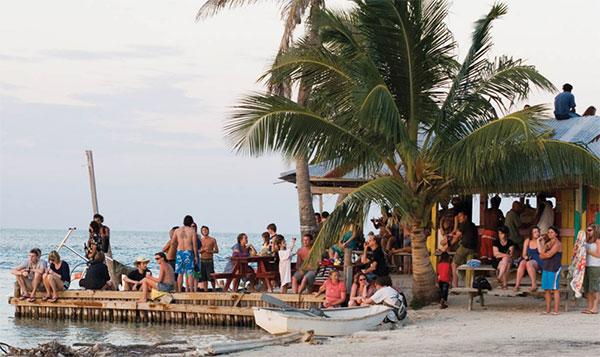DISCOVERING BELIZE’S BARRIER REEF
Immerse yourself in a spectacular underwater world of colorful corals, tropical fish, huge rays, barracudas, sharks, and turtles. The Belize Barrier Reef is a colossal epic – and was declared a Unesco World Heritage Site in December 1996 – offering some of the finest diving and snorkeling in the world.
The Belize Barrier Reef (which comprises the central section of the Great Maya Reef that stretches between the Yucatán and Honduras) is split into segments separated by relatively deep channels. Oxygen and plankton (free-floating microscopic plants and animals) carried by tides flush the Belize coastal zone twice daily through these channels, thereby feeding billions of hungry coral polyps and other reef creatures. As a result, the reef attracts large numbers of fish and is consequently superb for diving and snorkeling. Numerous companies offer diving, snorkeling, and sailing trips, making it a breeze to explore the reef.
Hundreds of species of fish are visible to snorkelers and divers over the coral reefs. Most ignore humans, unless the area has been heavily spear-fished. But there are exceptions. Barracudas have an unnerving habit of approaching and even following swimmers. This is pure curiosity – they normally move away when approached. Moray eels can inflict a nasty bite if annoyed. Sharks will sense you long before you see them, and usually move away. However, all sharks should be treated with caution. Even the nurse shark can become aggressive if molested.
Lying as close as 16km (10 miles) off the barrier reef are three of the very finest coral atolls in the Caribbean: Turneffe Atoll, Glover’s Reef, and Lighthouse Reef, whose combined reef systems comprise almost 225km (140 miles) of coral growth.
Coral reefs do not exist in isolation. Mangroves line much of the Belizean coastline, the cayes and lower reaches of the rivers. Seagrass beds, their blades swaying in the current like the long grass of spring meadows, blanket the sea floor between reef and shore. These mangrove and seagrass beds may not look as spectacular as coral reefs but, as giant marine nurseries, they form the foundation of the continuing long-term health of the country’s coastal zone.
The Split, at the north end of the village, is a channel through the island made by Hurricane Hattie in 1961. It’s one of the most popular gathering places on Caye Caulker, with a nice swimming area (be careful of the strong current and speedboats, however) and an open-air bar.
Caye Caulker’s big draw is, as with elsewhere on the Cayes, the accessibility to the longest Barrier Reef in the Western Hemisphere. Numerous tour operators offer diving, snorkeling, boating, and kayaking trips to the reef, where you can explore the colorful underwater world. Growing tourism has also meant growing pressure on the nearby reef. After a decade of requests from local fishermen and environmentalists, in 1999 the government gave preserve status to most of the reef in front of the caye.
At the island’s northern tip is the Caye Caulker Forest and Marine Reserve, home to mangroves, gumbo limbo, and poisonwood. Other native inhabitants of the reserve’s littoral forest include scaly-tailed iguanas (here called ‘wish willies’), geckos, and multiple species of land crab. Local tour companies will offer day trips here upon request.
Turneffe Atoll and Lighthouse Reef
Diving and fishing enthusiasts may venture further into the Caribbean to Belize’s three coral atolls. Although most watersport activities take place from charter boats, a surge of interest has fueled the development of a few island-based resorts. Two of these atolls, the Turneffe Atoll and Lighthouse Reef, can be reached from Belize City; the third, Glover’s Reef, is off the coast from Dangriga.
The Turneffe Atoll 7 [map] forms the surface elements of Belize’s largest atoll running some 30 miles (48km) from north to south; it has several shallow lagoons, a couple of upscale resorts and two lighthouses. The northernmost beacon, built in 1885, is on Mauger Caye (‘Skinny’ in creole) while a second lighthouse can be found on Caye Bokel (‘Elbow’ in Dutch) at the southern tip of the atoll. Almost all the major charter boat and dive services arrange trips to Turneffe, but guests at the various fishing and vacation lodges are usually picked up by the lodge’s own transportation from Belize City.

Watching the sunset at the Lazy Lizard bar on the Spit, Caye Caulker.
Corrie Wingate/Apa Publications
Tip
The luxurious Maruba Resort and Jungle Spa (www.maruba-spa.com) is a surprising attraction in this undeveloped area. Marked at Mile 40.5 on the highway, the hotel offers a range of therapeutic cures, as well as an excellent restaurant.
Lighthouse Reef 8 [map] is another atoll with a treacherous boundary of coral. Like Turneffe, there are also two lighthouses here, one on Sandbore Caye; the other, first built in 1828 and replaced in 1848, is on Half Moon Caye, a crescent-shaped island that is easily one of the most beautiful places in Belize. The abundance of nesting sea birds and marine life made Half Moon Caye and its surrounding waters a natural choice for the nation’s first Natural Monument in 1982. Around 4,000 red-footed booby birds nest on the island; the population is unusual for being white instead of the usual dull brown (the only other similar booby colony is near the island of Tobago in the eastern Caribbean). An observation platform allows unrestricted viewing of the boobies, along with some of the 98 other species of birds that have been recorded on the island.